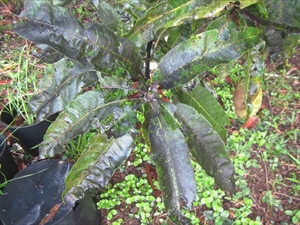- Narrow distribution. Southeast Asia, Oceania. On mango. There are two kinds of leafhoppers. Important pests.
- Adults dark brown, 4-5 mm, wedge shaped, breeding in flowers or in flowers and new leaf flushes. They cause flowers to brown and dry; and their honeydew excreta promotes black fungal growth on the leaves.
- Spread long distance via the nursery trade.
- Cultural control: none recommended.
- Chemical control: use synthetic pyrethroids or dimethoate. In Australia, two sprays are applied 7 days apart before flowering (reducing risk to pollinators). Dimethoate is sprayed or injected. (In Australia, dimethoate has been under review since mid-2015. It is no longer allowed for home garden use.)
Pacific Pests, Pathogens and Weeds - Online edition
Pacific Pests, Pathogens, Weeds & Pesticides
Mango leafhoppers (263)
Mango leafhoppers
Idioscopus nitidulus and Idioscopus clypealis.
AUTHOR Grahame Jackson
Information from CABI (2015) Idioscopus nitidulus (mango leafhopper) and Idioscopus clypealis (mango leafhopper) Crop Protection Compendium. (https://www.cabi.org/cpc/datasheet/28472) and (https://www.cabi.org/cpc/datasheet/28470), respectively; and from Chin D et al. (2010) Field guide to pests, beneficials, diseases and disorders of mangoes. Northern Territory Government, Department of Resources, Australia. (https://dpir.nt.gov.au/__data/assets/pdf_file/0006/227832/mango_field_guide.pdf). Photos 1-4 Joel Miles, National Invasive Species Coordinator, Bureau of Agriculture, Ministry of Natural Resources, Environment & Tourism, Republic of Palau.
Produced with support from the Australian Centre for International Agricultural Research under project PC/2010/090: Strengthening integrated crop management research in the Pacific Islands in support of sustainable intensification of high-value crop production, implemented by the University of Queensland and the Secretariat of the Pacific Community.







